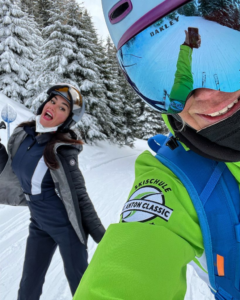In this blogpost I will give my take on how you can become a better, supportive ski buddy, when skiing with a person, who doesn’t have the same skiing level as you. But first I will give an example of the opposite, so you know what i’m talking about and how to avoid situations like this.
MAN TEACHES WOMAN
The man teaches the woman to ski. He is an experienced, skilled skier. She is lightly trained, but hasn’t been skiing for a long time. Her feeling on skis is almost like being completely new to the game. The couple starts together at the beginner’s area in the ski resort. It goes well. The man sees that she can easily get down here. He takes her up on a steeper slope. He tries to teach her what would be good for her to do in the current situation, but she doesn’t listen. He tries his best. He likes her and wants only the best for her. She doesn’t listen because she is already frustrated! She doesn’t have the ski skills to handle this steep and bumpy slope, which results in her being pressured and unable to keep up. She gets way too much out of her “comfort zone”. This causes her to be challenged so much that she panics, starts yelling and screaming and crying. The tension between these two persons is now high. The man doesn’t know what to do and looses patience. This leads to a huge argument out on the slopes. She takes off her skis and takes the ass ride down the slope. Afterwards, she does not want to talk to the man for several hours. The whole day is ruined. Maybe the holiday is ruined or the relationship! Next time she goes skiing, she probably has more fear & anxiety when skiing, just because of this experience.
Also read my Blogpost about Fear & Anxiety when skiing.
WHO’S TO BLAME ?
Situations like this should be avoided. You can not always say it’s the man’s fault or who’s to blame, because he is pushing her. BUT of course taking a person on a very steep slope, which she is not capable of doing is TOO MUCH. Then you are to blame. People mostly want other people the best. It’s good to think one extra time before skiing with “sensitive” skiers. Like some people have to think one extra time before talking. *LOL*. It’s al about human psychology.
JUST AN EXAMPLE
Perhaps you have tried similar situations?
Remember: Above is just an example. It doesn’t need to be man/woman situation. It could also be woman/man, mum/son, dad/dauther, friends, but this MAN TEACHING WOMAN TO SKI. I have seen this way too often out on the ski slopes.
WHAT TO DO?
1) FIRST SKI SCHOOL
In cases like this above, the best advice is always to send the “not so good skier” to a professional ski instructor or ski school. Achieve private lessons or group lessons. Depending on the person. It’s less stressful for you and the investment worth it.
One of my ski client’s once told me it’s cheaper to send his wife to me as getting divorced!
2) SKIING TOGETHER AFTER THE SKI LESSON
After the ski lesson and lunchbreak you could ski a bit together. The person, who went to ski school, could show what he/she has learned in the lesson. When this is going to happen, there are just some small things you could have in mind while skiing together. It will give the skiing experience together a much better energi flow.
HOW TO BE A SUPPORTIVE SKI FELLOW
- Don’t act like her/his ski instructor. People who knows each other too well, doesn’t always want to listen to each other as if it was a stranger, who listened. It can create frustration. That’s also a reason why don’t teach your wife, but Support!
- On the person’s terms. Don’t ski over level. Then the bad circle will start…
- Be present. Don’t always wait 100 meters down the hill. Not that “The slow person” always has to feel slow or think “F…” they are always waiting for me”. That’s bad for the head.
- Think of where you make breaks or meeting points on the slope. Do not stand near the edge of the piste far away down, as people with anxiety think they cannot turn or stop in time – and on a bad day, they might crash
- If you MUST to go on a red slope (no other option) and the person only likes blue, then it’s very important to ski down the red without the less experienced skier notice it
- Praise
- Less is more. If too much tension is building up, then stop skiing. Enough is enough. Go for a drink or beer. Less is more. Enough is enough. Skiing should be fun for everybody. Skiing experience together creates great bonds with each other as well.
I hope you got some inspiration. Let me know if you can use my advice. Also if you have more good things that I could add to the written above.
Anne-Louise S. Jørgensen






